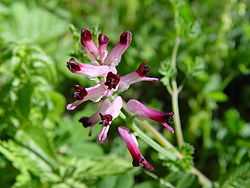Fumaria officinalis
| Fumaria officinalis | |
|---|---|
 | |
| Scientific classification | |
| Kingdom: | Plantae |
| (unranked): | Angiosperms |
| (unranked): | Eudicots |
| Order: | Ranunculales |
| Family: | Papaveraceae |
| Genus: | Fumaria |
| Species: | F. officinalis |
| Binomial name | |
| Fumaria officinalis L. | |
Fumaria officinalis (Common Fumitory or Earth smoke) is the most common species of the genus Fumaria in Western and Central Europe.
Description
It is an herbaceous annual plant, which grows weakly erect and scrambling, with stalks about 10 to 50 cm long. Its pink 7 to 9mm flowers appear from April to October in the northern hemisphere. They are two lipped and spurred, with sepals running a quarter the length of the petals.[1] The fruit is an achene. It contains alkaloids, potassium salts, and tannins. It is also a major source of fumaric acid. The "smoky" or "fumy" origin of its name is uncertain.
Herbalism
It was traditionally thought to be good for the eyes, and to remove skin blemishes. In modern times herbalists use it to treat skin diseases, and conjunctivitis; as well as to cleanse the kidneys. However, Howard (1987) warns that fumitory is poisonous and should only be used "under the direction of a medical herbalist."[2]
Chemical constituents

The plant contains isoquinoline alkaloids protopine and allocryptopine. Both protopine and allocryptopine increased CYP1A1 and CYP1A2 mRNA levels in human hepatocyte cells. The use of products containing protopine and/or allocryptopine may be considered safe in terms of possible induction of CYP1A enzymes.[3]
References
- ↑ Fitter, Richard; Fitter, Alastair; Blamey, Marjorie (1974). The Wild Flowers of Britain and Northern Europe. London: Collins. p. 78. ISBN 00021905705 Check
|isbn=value (help). - ↑ Howard, Michael. Traditional Folk Remedies (century, 1987). pp142-3.
- ↑ Vrba, J.; Vrublova, E.; Modriansky, M.; Ulrichova, J. (2011). "Protopine and allocryptopine increase mRNA levels of cytochromes P450 1A in human hepatocytes and HepG2 cells independently of AhR". Toxicology Letters 203 (2): 135–141. doi:10.1016/j.toxlet.2011.03.015. PMID 21419197.
| Wikimedia Commons has media related to Common fumitory (Fumaria officinalis). |